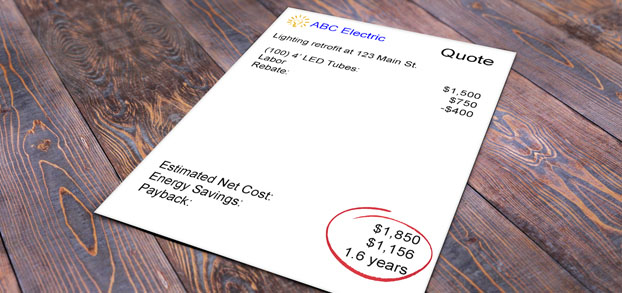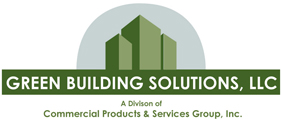Green Building Solutions is partnering with BriteSwitch®
To facilitate our clients access to available rebates. All projects should be checked to see if they are eligible for incentives. Green Building Solutions and BriteSwitch® will advise and handle all filings for rebates. Green Building Solutions and BriteSwitch® can get you the most money with no hassle.
5 Misconceptions About Lighting Rebates
Lighting rebates have been around since the 80s, yet many people still have some long-held, misplaced beliefs about these incentives. Here we’ll shed some light on some of the more common misconceptions.
1) LED Rebates Are Going Away
With LEDs penetrating the market more and more each year, many people think rebates for these products no longer exist. However, that isn’t the case at all. The availability of rebates has remained relatively consistent throughout the years. While some programs may have been discontinued, we’ve also seen several large programs, like APS in Arizona and TVA in Tennessee, reinstate lighting rebates after previously stopping them. If we look at North America as a whole, 77% of the US still has lighting rebates available. That’s just shy of the record of 79% that was seen in 2017.
In terms of incentive levels, in 2022, the rebate amounts for LED lighting stayed flat for the second year in a row. That goes against the previous multi-year trend of these amounts dropping 10 – 20% each year.
2) Any LED Can Qualify for the Rebate
People who are inexperienced with rebates are surprised that not every LED will qualify for an incentive. We constantly hear from customers who purchased the cheapest LED available and are disappointed when they learn they can’t get the rebate.
Most incentive programs have technical specifications that a product must meet to qualify for a rebate. Usually, for lighting, it comes down to whether or not the lighting solution is on one of the following lists:
Design Lights Consortium (DLC)
This non-profit organization provides qualified product lists for many types of commercial lighting, such as linear tubes, high bays, pole lights, and similar fixtures. They also maintain lists for networked lighting controls and horticulture lighting. Depending on the technology, 60 – 75% of rebates require the solution to be DLC listed.
Energy Star is a program by the EPA and the Department of Energy. They provide certification lists for lighting that may be installed in residential and commercial applications. Common product types are incandescent replacement lamps (A19), downlights, and accent lighting. About 70% of all rebate programs require Energy Star depending on the product category.
It’s essential that the selected product is actively on the list’s website. An EnergyStar or DLC logo on a spec sheet or product listing is not sufficient proof of qualification. Most rebate programs will look at the qualified product list during the application process to verify eligibility. This is especially important as DLC will be transitioning from v5.0 specifications to v5.1 later this year, and some products may fall off the list.
3) It’s Easy to Get the Rebate
To be fair, most programs try to make it easy to get the rebate, but few achieve this goal. Lengthy forms, poorly built online portals, and centralized call centers make it cumbersome to apply for commercial lighting rebates. It can be even more of a logistical nightmare if you’re working on a multi-site project across several programs at once.
The same hassle applies to midstream programs, where the lighting distributor takes the rebate right off the invoice. In this case, the process for the customer is simplified, but the burden of gathering and reporting the correct data for reimbursement still falls on the distributor.
We’ve reviewed the thousands of rebate applications we filed over the years, and it takes 5-6 months and 12 steps on average to complete the rebate process. That means someone has to be responsible for shepherding the project through the process from beginning to end. Some companies will use a dedicated project manager or rebate analyst, while others outsource the burden to a third-party rebate processor.
4) Everyone Knows How To Get the Rebate
We often hear someone say, “my contractor is handling the rebate; it’s in the contract,” but does anyone follow up on that? It’s essential to investigate on your own to ensure you’re getting ALL the rebates and incentives available to you. Inexperienced personnel may miss important details or forget to file pre-approvals. They may also just focus on the low-hanging fruit and leave valuable money on the table. Just like how 50% of all Americans use a tax preparer to file their taxes each year, many companies use professional rebate processors to help them get the most money possible.
For those looking to file for the rebates themselves, it’s crucial to stay up to date on programs and upcoming changes. If a rebate program offers a trade ally designation, it’s often beneficial to sign-up. While it usually requires filling out some forms, providing references, and attending trainings, being a trade ally has some advantages. Programs will typically give you a head’s up on upcoming changes. They may also assign a dedicated point of contact who can help with issues.
Another way to stay on top of rebates is to use software like RebatePro, which makes it easy to find and estimate the rebate projects on your own. It puts virtually all the commercial lighting rebates in North America at your fingertips, saving you the countless hours it takes to reach out to each utility for details. This means rebate staff can focus on the essential things and not waste time looking up basic information.

5) The Rebate Amounts Aren’t Worth the Hassle
As we mentioned, the rebate amounts for commercial lighting are lower than in the past, but it’s still “free” money. It’s hard to believe that some customers pass up on these valuable incentives because of time or manpower constraints, especially when third parties are available to do all the hard work. While a $25,000 rebate on a $250,000 project may seem small in the grand scheme of things, would any company turn down a job that resulted in a $25,000 cost savings? This fact is especially true today, where price increases are common across the industry.
Don’t Miss Out On These Rebates
As you can see, rebates for LED lighting and controls are as strong as ever. All projects should be checked to see if they’re eligible for incentives. The extra time that it takes to do the research could be the very thing that pushes the job forward.
If you are planning a project and need help with estimating and filing rebates, Green Building Solutions and BriteSwitch® can get you the most money with no hassle.
If you file for rebates yourself, our RebatePro tool is a great resource that speeds up the process of estimating and filing rebates. It’ll save you from the most tedious part of rebate processing and allow you to focus on the most important things, like overall project management. We designed it based on our experience managing thousands of applications over the last 13 years, so it’s uniquely suited to help people who process rebates themselves.
